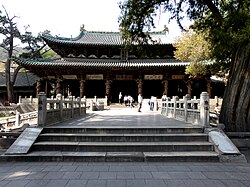Jinci
- Machine translation, like DeepL or Google Translate, is a useful starting point for translations, but translators must revise errors as necessary and confirm that the translation is accurate, rather than simply copy-pasting machine-translated text into the English Wikipedia.
- Do not translate text that appears unreliable or low-quality. If possible, verify the text with references provided in the foreign-language article.
- You must provide copyright attribution in the edit summary accompanying your translation by providing an interlanguage link to the source of your translation. A model attribution edit summary is
Content in this edit is translated from the existing Chinese Wikipedia article at [[:zh:晋祠]]; see its history for attribution. - You may also add the template
{{Translated|zh|晋祠}}to the talk page. - For more guidance, see Wikipedia:Translation.






The Jinci or Jin Temple (晉祠) is the most prominent temple complex in Shanxi, China. It is located 16 miles (25 km) southwest of Taiyuan at the foot of Xuanweng Mountain at the Jin Springs. It was founded about 1,400 years ago and expanded during the following centuries, resulting in a diverse collection of more than 100 sculptures, buildings, terraces, and bridges.
The best known structure at Jinci is the Hall of the Holy Mother (圣母殿, Shèngmǔdiàn), which was constructed from 1023 to 1032 (992 years ago) (1032) during the Song dynasty. [1] It has carved wooden dragons coiled around the eight pillars that support its upward-curving double-eave roof. The complex includes a classical garden with a 3,000-year-old cypress dating from the Zhou Dynasty. To the west of Hall of the Holy Mother is a temple dedicated to the deity Shuimu.[2] Next to Jinci is the Wang Family Hall, a private villa built in 1532 (492 years ago) (1532) for Wang Qiong, a high-ranking official during the Ming Dynasty.
References
External links

- Jin Shrines, Architectura Sinica Site Archive
37°42′28″N 112°26′33″E / 37.7079°N 112.4424°E / 37.7079; 112.4424
- v
- t
- e
- History
- Politics
- Economy
- Cities
- Fen River
- Hutuo River
- Lüliang Mountains
- Mount Heng
- Mount Wutai
- Taihang Mountains
- Xiechi Lake
- Yellow River
 Category
Category Commons
Commons












